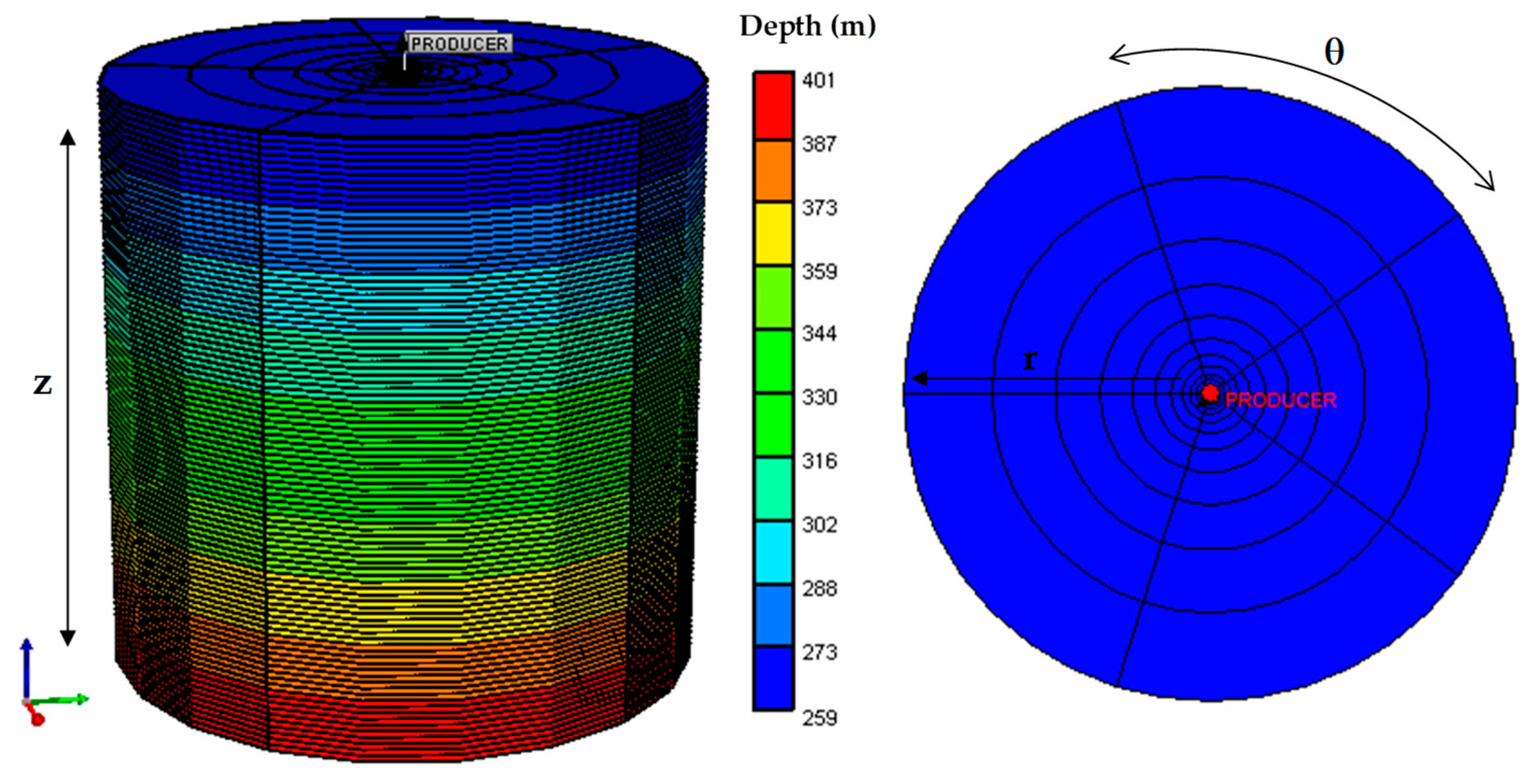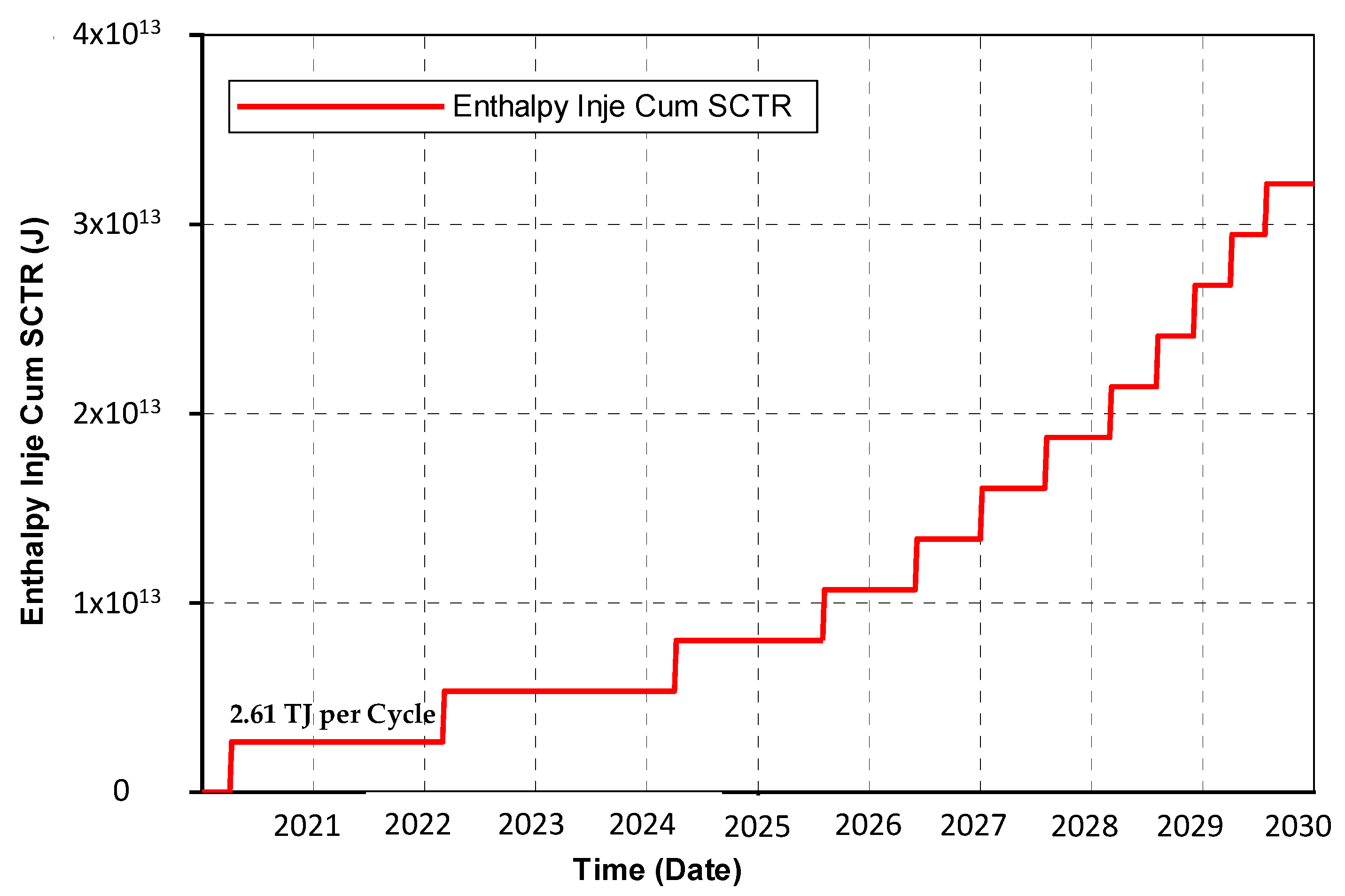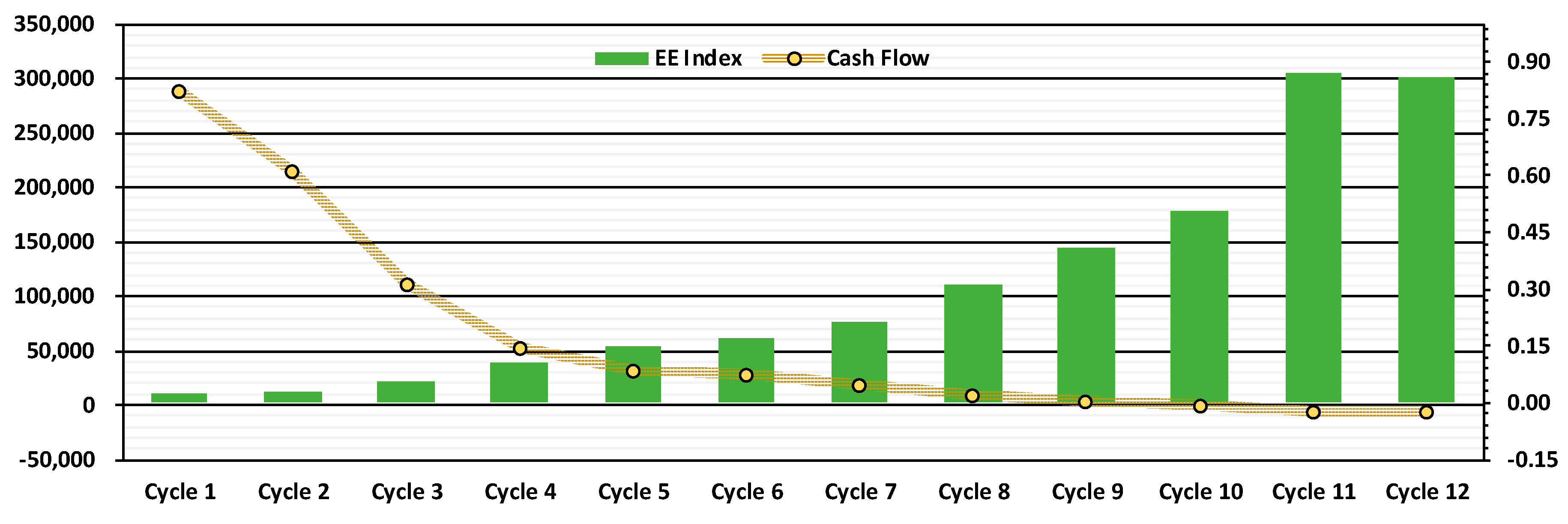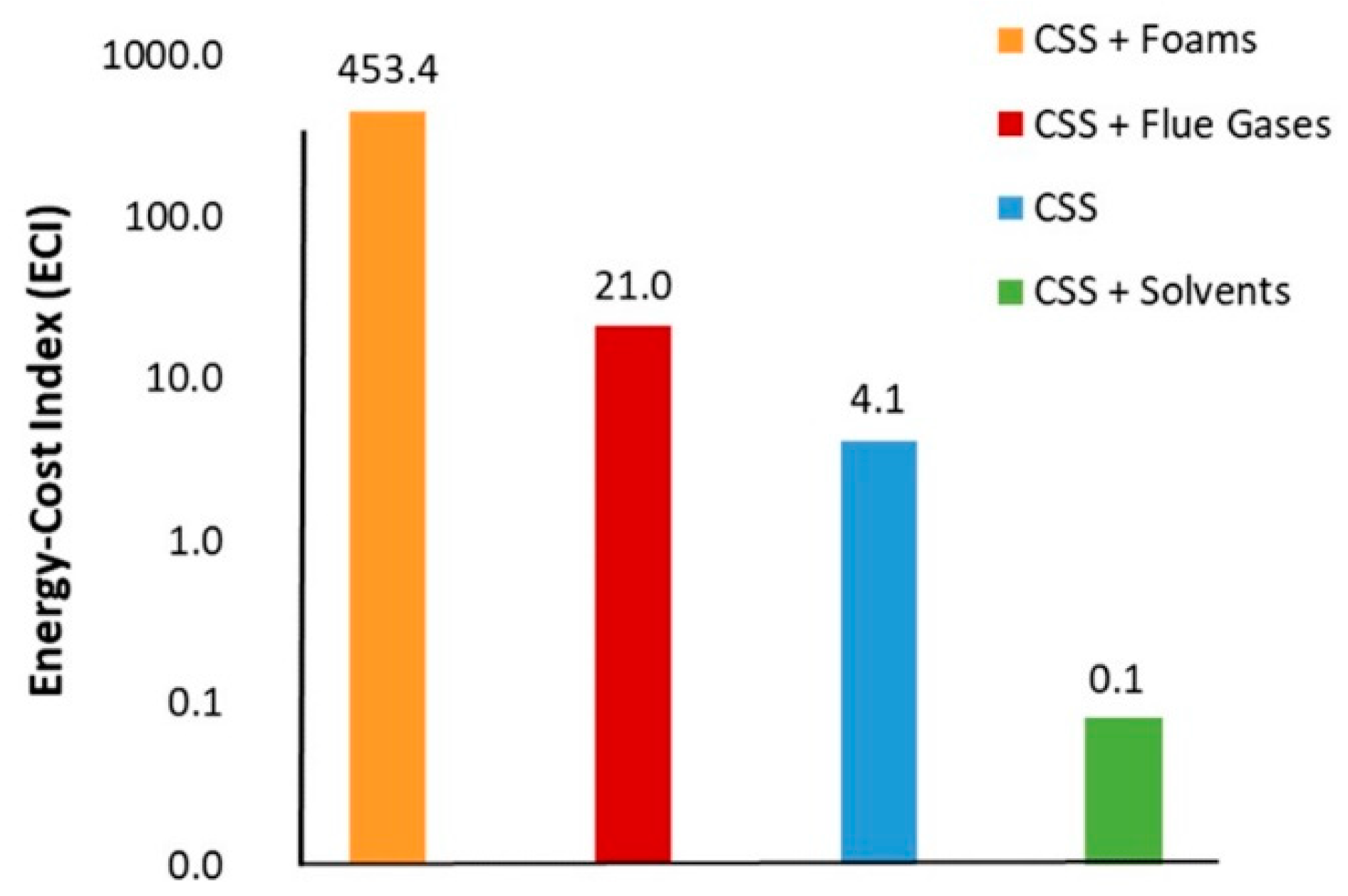Benefit–Cost and Energy Efficiency Index to Support the Screening of Hybrid Cyclic Steam Stimulation Methods
Abstract
:1. Introduction
- Solar energy is the renewable energy source with the largest potential for steam generation in some regions with high enough direct normal irradiation (DNI).
- Downhole heating technologies (including steam recirculation) show the greatest potential before starting CSS.
- Some limitations were identified during the simulation of hybrid CSS methods. Examples include
- Trapped gas and hysteresis effects during CSS with gas (e.g., flue gas, CO2, or N2).
- Solvent: crude oil interactions and the interpretation of oil recovery mechanisms injecting mixtures of propane:butane (CSS with solvents).
- Representation of crude oil in situ upgrading during CSS with nanoparticles.
- Hybrid CSS with nanoparticles or solvents performed best at early stages of CSS (second to fourth cycles). In contrast, hybrid CSS with foams or flue gas improved oil recovery at later stages of CSS (sixth cycle or higher).
2. Methodology
- Steam injection (volume and conditions) was the same as that used for the baseline and was kept constant for all hybrid CSS methods tested.
- CSS with foam was modeled using six reactions that simulated the coalescence of foam and its regeneration over time. Four new components were included in the fluid section (surfactant, nitrogen, lamella, and trapped gas). The foam was preformed with nitrogen before its injection. Foam treatment using a surfactant concentration of 0.25 v/v was injected before the steam cycle. A total of 7 t of surfactant was injected over a period of 3 days.
- In this study, the hybrid CSS with solvent considered the use of liquefied petroleum gas (LPG). The injection was done in batches, starting with a half-day steam batch of 107.2 m3 (675 bbls), followed by the vaporized LPG slug of 138,488 m3 (4,890,672 ft3), and finishing with a second and final steam batch of 1180.6 m3 (7425 bbls).
- CSS with flue gas was performed under immiscible conditions (no oil–flue-gas interaction). Molar gas composition was 83% N2 and 17% CO2. The injection scheme used in this study consisted of 3 days of flue gas injection at 141,584 Sm3/day (5 MM Sft3/day), followed by the steam cycle.
- Hybrid CSS with nanoparticles was based on laboratory data documented in the literature. The main modeling mechanism was the in situ upgrading (oil viscosity reduction reaction due to the interaction of the crude oil and the nanoparticles). Simulation parameters included the activation energy (13,715,728 J/mol, or 13,000 BTU/mol), frequency factor (1.8 day−1), cracking temperature (210 °C, or 410 °F), improved oil density (928.59 kg/m3, or 57.97 lb/ft3), and molecular weight of the upgraded oil (243 kg/kgmol, or 243 lb/lbmol). A viscosity reduction of 70% was assumed in this study, as reported by Perez et al. [12].
3. Results
3.1. Hybrid CSS Methods
3.1.1. CSS with Nanoparticles
3.1.2. CSS with Foam, LPG, or Flue Gas
- CSS with Foam:
- The surfactant injected was a commercial alpha olefin sulfonate (AOS) at a cost of US$ 4300/t. To inject 7000 kg (7 t) of surfactant, a total of 64,279.24 m3 (2.27 MMft3) of N2 was required.
- The energy required to inject the foam (surfactant and N2) included the fuel (diesel) consumption to generate N2 (1 m3 of diesel for 6238.7 m3 of N2, or 1 gal of diesel for 834 ft3 of N2). Diesel energy content used was 38,308 MJ/m3 (137,381 BTU/gal).
- CSS with LPG:
- LPG values were representative of a local supplier, with a density of approximately 0.54 kg/L (1 L of LPG liquid ≈ 0.273 m3, or 273 L, or 9.64 ft3 of LPG gas).
- LPG energy content used was 25,467 MJ/m3 (91,330 BTU/gal).
- CSS with Flue Gas:
4. Discussions
- The strategy to inject a stable stream of steam with dispersed nanoparticles and its propagation through the reservoir has important uncertainties for this recovery process at numerical and field scales.
- The impact of type, size, and concentration of nanoparticles on reservoir permeability needs to be addressed [16]. However, the impact of permeability reduction due to the injection of nanoparticles is expected to be lower during CSS compared with CSI. This is based on the huff-and-puff nature of CSS operations and the high permeability characteristic of heavy oil reservoir candidates to steam injection. It is important to remark that the type, size, and concentration of nanoparticles did not represent a key objective in this simulation study. First and foremost, commercial simulators are not fully capable of simulating the injection, flow, and potential entrapment of nanoparticles. On the other hand, this methodology is intended to provide some insights during screening stages of hybrid CSS technologies. As of today, there is no commercial application that can justify the viability of this hybrid technology given the uncertainties (e.g., injection method, possible filtration effects during the injection and propagation in the reservoir, etc.) associated with this recovery process.
- Solvent recovery must be included for the success of this recovery process. This was also addressed by Bayestehparvin et al. [5] based on state-of-the-art solvent-based and solvent-assisted recovery processes.
- If CSS with solvents is developed to precipitate asphaltenes, the benefits of in situ upgrading should be included in the B/C ratio calculations (not considered in this study). However, the risk of possible permeability reduction due to asphaltene deposition in the porous media represents another uncertainty of this hybrid CSS method.
- High-oil-price scenarios and high solvent recovery rates will definitively improve the B/C ratio of CSS with LPG (solvents). However, the recovery efficiency of the solvent injected and the energy required to separate it (for reutilization purposes) should be considered in the estimation of EE indices. This represents important uncertainties that diminish the technical and economic feasibility of this recovery process in Colombian assets.
- Trapped gas and its possible effects on the hysteresis of relative permeability. The main goal of flue gas injection is to generate the flow diversion due to the trapped gas in lower oil saturation zones saturated with water (condensed steam). However, trapped gas effects can also be influenced by gas segregation due to high vertical communication within the net pay of the reservoir (Kv/Kh > 0.3) and/or the huff and puff of CSS operations.
- CSS with flue gas (or any other gas) must be carefully designed to avoid high near-wellbore repressurization, which could negatively affect the steam quality at downhole conditions.
5. Conclusions
Author Contributions
Funding
Acknowledgments
Conflicts of Interest
Abbreviations and Conversion Factors
| °C | Degrees Celsius, 1 °C = 33.8 °F |
| °F | Degrees Fahrenheit |
| B/C | Benefit–cost ratio |
| bbl | Barrels |
| BOE | Barrel of oil equivalent; 1 BOE = 5.722 × 106 BTU |
| BTU | British thermal units, 1 BTU = 1055.56 J |
| CO2 | Carbon dioxide |
| CAPEX | Capital expenditure |
| CSI | Continuous steam injection |
| CSS | Cyclic steam injection |
| CSOR | Cumulative steam/oil ratio |
| D | Darcy |
| d | Day |
| DNI | Direct normal irradiation |
| EE | Energy efficiency index |
| ECI | Energy cost index |
| ft3 | Cubic foot |
| ft | Foot |
| FR | Recovery factor |
| gal | Gallon |
| J | Joule |
| kg | Kilogram |
| Kv/Kh | Relation between vertical and horizontal permeability |
| KPa | Kilopascals, 1 KPa = 1000 Pa |
| L | liter |
| lb | Pound |
| LPG | Liquefied petroleum gas |
| m2 | Square meter, 1 m2 = 0.000247 acres |
| m3 | Cubic meter; 1 m3 = 6.29 bbl, 1 m3 = 1000 L; 1 m3 = 264.17 gal |
| m | Meter; 1 m = 3.28 ft |
| MMB | Middle Magdalena Basin |
| MCF | 1000 cubic feet |
| MJ | Mega Joules; 1 MJ = 106 J |
| MM | Millions |
| N2 | Nitrogen |
| NOX | Nitrogen oxides |
| OPEX | Operational expenditures |
| Pa | Pascal |
| Pb | Bubble pressure |
| Psi | Pounds per square inch, 1 psi = 6894.7 Pa |
| S | Standard |
| scf | Standard cubic foot |
| SF | Steam flooding |
| SOX | Sulfur oxides |
| STB | Stock tank barrels |
| t | Ton |
| SAGD | Steam-assisted gravity drainage |
| STL | Stock tank liquid |
| TJ | Terajoule; 1 TJ = 1012 J |
| US$ | American dollars |
References
- Alvarado, V.; Manrique, E. Enhanced oil recovery: An update review. Energies 2010, 3, 1529–1575. [Google Scholar] [CrossRef]
- Koottungal, L. Survey: Miscible CO2 continues to eclipse steam in US EOR production—2014 worldwide EOR survey. Oil Gas J. 2014, 112, 78–91. [Google Scholar]
- U.S. Energy Information Administration: Petroleum & Other Liquids. Available online: https://www.eia.gov/petroleum/drilling/#tabs-summary-2 (accessed on 18 April 2019).
- Alvarez, J.; Han, S. Current Overview of Cyclic Steam Injection Process. J. Pet. Sci. Res. 2013, 2, 116–127. [Google Scholar]
- Bayestehparvin, B.; Farouq Ali, S.M.; Abedi, J. Solvent-Based and solvent-assisted recovery processes: State of the art. SPE Res. Eval. Eng. 2019, 22. [Google Scholar] [CrossRef]
- Dong, X.; Liu, H.; Chen, Z.; Wu, K.; Lu, N.; Zhang, Q. Enhanced oil recovery techniques for heavy oil and oilsands reservoirs after steam injection. Appl. Energy 2019, 239, 1190–1211. [Google Scholar] [CrossRef]
- Trigos, E.M.; Rueda, S.F.; Rodríguez, E.; Rivera de la Ossa, J.E.; Naranjo, C.E. Key strategies in the heat management for steamflooding projects, Teca Field Application. In Proceedings of the SPE Enhanced Oil Recovery Conference, Kuala Lumpur, Malaysia, 2–4 July 2013. [Google Scholar] [CrossRef]
- Pang, W.; He, Z.; Wu, Q.; Hou, Q. EOR enhancement potential analysis for one oilfield. In Proceedings of the SPE Asia Pacific EOR Conference, Kuala Lumpur, Malaysia, 11–13 August 2015. [Google Scholar] [CrossRef]
- Franco, F.; Useche, M.; Vargas, L. Workflows to Assist in Managing a Heavy Oil Field in the Middle Magdalena Basin, Colombia. In Proceedings of the SPE International Heavy Oil Conference and Exhibition, Kuwait City, Kuwait, 10–12 December 2018. [Google Scholar] [CrossRef]
- Rodríguez, E.; Barrios, W.; Sandoval, R.; Santos, N.; Cortes, I. Numerical simulation for cyclic steam injection at santa clara field. C.T.F Cienc. Tecnol. Futuro 2008, 3, 107–128. [Google Scholar]
- Mansarovar Energy: Technologies at Mansarovar Energy. Available online: http://www.mansarovar.com.co/en/operaciones/cadena-de-valor/desarrollo (accessed on 19 April 2019).
- Pérez, R.; Sandoval, J.; Barbosa, C.; Delgadillo, C.; Trujillo, M.; Osma, L.; Bottet, J.; Garcia, L.; Rodríguez, H. Comparación de alternativas para mejora de la inyección cíclica de vapor mediante simulación numérica. Revista Fuentes 2018, 16, 91–108. (In Spanish) [Google Scholar] [CrossRef]
- U.S. Energy Information Administration. Units & Calculators—British Thermal Units (BTU). Available online: https://www.eia.gov/energyexplained/index.php?page=about_btu (accessed on 19 April 2019).
- Farouq Ali, S.M. Heavy Oil Recovery: Principles, Importance, Status and Operation, Course Manual, Bogota, 19–22 August 2014. Available online: https://www.scribd.com/document/328623172/EOR-Course-Slides-by-Farouq-Ali (accessed on 21 May 2019).
- Agista, M.N.; Guo, K.; Yu, Z. A State-of-the-Art review of nanoparticles application in petroleum with a focus on enhanced oil recovery. Appl. Sci. 2018, 8, 871. [Google Scholar] [CrossRef] [Green Version]
- Druetta, P.; Raffa, P.; Picchioni, F. Plenty of room at the bottom: Nanotechnology as solution to an old issue in enhanced oil recovery. Appl. Sci. 2018, 8, 2596. [Google Scholar] [CrossRef] [Green Version]
- Nassar, N.N.; Hassan, A.; Pereira-Almao, P. Application of nanotechnology for heavy oil upgrading: Catalytic steam gasification/cracking of asphaltenes. Energy Fuels 2011, 25, 1566–1570. [Google Scholar] [CrossRef]
- Shokrlu, Y.H.; Babadagli, T. Viscosity reduction of heavy oil/bitumen using micro and nano metal particles during aqueous and non-aqueous thermal applications. J. Pet. Sci. Eng. 2014, 119, 210–220. [Google Scholar] [CrossRef]
- Clark, P.D.; Clarke, R.A.; Hyne, J.B.; Lesage, K.L. Studies on the effect of metal species on oil sands undergoing steam treatments. Aostra J. Res. 1990, 6, 53–64. [Google Scholar]
- Shokrlu, Y.H.; Babadagli, T. In situ upgrading of heavy oil/bitumen during steam injection by use of metal nanoparticles: A study on in situ catalysis and catalyst transportation. SPE Reserv. Eval. Eng. 2013, 16, 333–344. [Google Scholar] [CrossRef]
- Choi, S.U.S.; Eastman, J.A. Enhancing thermal conductivity of fluids with nanoparticles. In Proceedings of the ASME International Mechanical Engineering Congress & Exposition, San Francisco, CA, USA, 12–17 November 1995; 1995; Volume 231, pp. 99–106. [Google Scholar]
- Xuan, Y.; Li, Q. Heat Transfer enhancement of nanofluids. Int. J. Heat Fluid Flow 2000, 21, 58–64. [Google Scholar] [CrossRef]
- Choi, S.U.S.; Zhang, Z.G.; Yu, W.; Lockwood, F.E.; Grulke, E.A. Anomalous thermal conductivity enhancement in nanotube suspensions. Appl. Phys. Lett. 2001, 79, 2252–2254. [Google Scholar] [CrossRef]
- Mohammad, A.A.A.; Mamora, D.D. In-situ upgrading of heavy oil under steam injection with tetralin and catalyst. In Proceedings of the Internationsl Thermal Operations and Heavy Oil Symposium, Calgary, Canada, 20–23 October 2008. [Google Scholar] [CrossRef]
- Franco, C.A.; Cardona, L.; Lopera, S.H.; Mejía, J.M.; Cortés, F.B. Heavy oil upgrading and enhanced recovery in a continuous steam injection process assisted by nanoparticulated catalysts. In Proceedings of the SPE Improved Oil Recovery Conference, Tulsa, OK, USA, 11–13 April 2016. [Google Scholar] [CrossRef]
- Yi, S.; Babadagli, T.; Li, H.A. Use of nickel nanoparticles for promoting aquathermolysis reaction during cyclic steam stimulation. In Proceedings of the International Petroleum Technology Conference, Bangkok, Thailand, 14–16 November 2016. [Google Scholar] [CrossRef]
- Alomair, O.; Alajmi, A. Experimental study for enhancing heavy oil recovery by nanofluid followed by steam flooding NFSF. In Proceedings of the SPE Heavy Oil Conference & Exhibition, Kuwait City, Kuwait, 6–8 December 2016. [Google Scholar] [CrossRef]
- Maity, S.K.; Ancheyta, J.; Marroquín, G. Catalytic aquathermolysis used for viscosity reduction of heavy crude oils a review. Energy Fuels 2010, 24, 2809–2816. [Google Scholar] [CrossRef]
- Hamedi Shokrlu, Y. Enhancement of Heavy Oil/Bitumen Thermal Recovery Using Nano Metal Particles. Ph.D. Thesis, University of Alberta, Edmonton, Alberta, 2013. [Google Scholar]
- Sigma-Aldrich (Merck). Nickel (II) Oxide: 637130-250G. Available online: https://www.sigmaaldrich.com/catalog/product/aldrich/637130?lang=en®ion=CO (accessed on 20 April 2019).
- Ahmadi, M.A.; Hasanvand, M.Z.; Shokrolahzadeh, S. Technical an economic study of flue gas injection in an Iranian oil field. Petroleum 2015, 1, 217–222. [Google Scholar] [CrossRef] [Green Version]
- Zhdanov, S.A.; Amiyan, A.V.; Surguchev, L.M.; Castanier, L.M.; Hanssen, J.E. Application of foam for gas and water shut-off: Review of field experience. In Proceedings of the SPE European Petroleum Conference, Milan, Italy, 22–24 October 1996. [Google Scholar] [CrossRef]
- Delamaide, E.; Cuenca, A.; Chabert, M. State of the Art of the Steam Foam Process. In Proceedings of the SPE Latin America and Caribbean Heavy and Extra Heavy Oil Conference, Lima Peru, 19–20 October 2016. [Google Scholar] [CrossRef]
- Petroleum Resources Management System (PRMS)—2018 Updates. Available online: https://www.spe.org/en/industry/petroleum-resources-management-system-2018/ (accessed on 22 January 2019).







| Variable | Value |
|---|---|
| Porosity (Fraction) | 0.23 |
| Permeability (Darcy) | 1.17 |
| Vertical-to-horizontal permeability ratio—Kv/Kh (Fraction) | 0.3 |
| Depth (m) | 259–401 |
| Initial pressure (KPa) | 4619.5 |
| Initial temperature (°C) | 40.55 |
| Oil gravity (°API @ standard conditions) | 12 |
| Oil viscosity (cP @ standard conditions) | 44,475 |
| OOIP (m3) | 161,685 |
| Variable | Value |
|---|---|
| Oil price (US$/bbl) 1 | 50 |
| Oil quality deduction (US$/bbl) | 7.08 |
| Oil transport deduction (US$/bbl) | 2.84 |
| Lifting costs (US$/bbl) | 13.2 |
| Cost of energy (US$/MMBTU) 2 | 7.05 |
| Tax deduction (%) | 33 |
| Royalties (%) | 8 |
| Parameter | Early Stages (Second Cycle) | Intermediate Stage (Sixth Cycle) |
|---|---|---|
| Incremental Oil Production (bbls) (m3) | (14,479) 2301 | (2591) 411.9 |
| Production Associated with Royalties (bbls) (m3) | (1158) 184.1 | (207) 32.9 |
| Net Incremental Production (bbls) (m3) | (13,321) 2117 | (2384) 379 |
| Net Incomes (US$) | 533,906 | 95,551 |
| Lifting Cost (US$) | 191,123 | 34,201 |
| Required Energy (MMBTU) 1 | 4946 | 4946 |
| Cost of Energy Required (US$) | 34,869 | 34,869 |
| Expenses (US$) | 225,992 | 69,070 |
| B/C Ratio | 2.36 | 1.38 |
| Parameter | Early Stages (Second Cycle) |
|---|---|
| Incremental Oil Production, bbls, (m3) | 10,963 (1743) |
| Production Associated with Royalties, bbls, (m3) | 877 (139) |
| Net Incremental Production, bbls, (m3) | 10,086 (1604) |
| Net Incomes (US$) 1 | 404,247 |
| Lifting Cost (US$) | 144,712 |
| Mass of Nanoparticles Injected, t, (kg) | 1.9 (1925) |
| Nanoparticle Cost (US$) 2 | 2,598,750 |
| Injection Costs (US$) 3 | 8000 |
| Expenses (US$) | 144,712 |
| Operational Expenditures (OPEX) (US$) | 2,606,708 |
| B/C Ratio | 0.15 |
| Parameter | CSS with Foam | CSS with Solvents | CSS with Flue Gas |
|---|---|---|---|
| Incremental Oil Production, bbls, (m3) | 13,444 (2137) | 1088 (173) | 3564 (567) |
| Production Associated with Royalties, bbls, (m3) | 1076 (171) | 87 (14) | 285 (45) |
| Net Incremental Production, bbls, (m3) | 12,368 (1966) | 1001 (159) | 3279 (522) |
| Net Incomes (US$) | 495,709 | 40,120 | 131,418 |
| Lifting Cost (US$) | 177,461 | 14,362 | 47,045 |
| Injected Surfactant, t, (kg) | 7 (7000) | n.a. | n.a. |
| Surfactant Cost (US$) | 30,100 | n.a. | n.a. |
| Nitrogen Unit Rental Cost (US$) | 16,365 1 | n.a. | n.a. |
| Volume of LPG Injected, ft3, (m3) | n.a. 2 | 4,890,672 (138,488) | n.a. |
| LPG Cost (US$) | n.a. | 232,146 4 | n.a. |
| Costs of Storage Tanks (US$) | n.a. | 1073 5 | n.a. |
| Pumping Costs (US$) | 0 3 | 1000 | 3000 |
| Vol. of Flue Gas Injected, MM ft3, (m3) | n.a. | n.a. | 15 (424,752) |
| Cost of Flue Gas (US$) | n.a. | n.a. | 1500 |
| Expenses (US$) | 177,461 | 14,362 | 47,045 |
| OPEX (US$) | 46,465 | 234,146 | 4500 |
| B/C Ratio | 2.21 | 0.16 | 2.55 |
| Parameter | CSS 1 with Foam | CSS 1 with Solvents | CSS 1 with Flue Gas |
|---|---|---|---|
| Energy required to generate foam, MMBTU, (TJ) | 375 2 (0.396) | n.a. 3 | n.a. |
| Energy of LPG injected, MMBTU, (TJ) | n.a. | 12,256 4 (12.937) | n.a. |
| Energy required to inject flue gas, MMBTU, (TJ) | n.a. | n.a. | 2471 (2.608) |
| Energy produced, MMBTU 5, (TJ) | 76,927 (81.201) | 6226 (6.572) | 20,393 (21.526) |
| EE index | 0.005 | 1.969 | 0.121 |
© 2019 by the authors. Licensee MDPI, Basel, Switzerland. This article is an open access article distributed under the terms and conditions of the Creative Commons Attribution (CC BY) license (http://creativecommons.org/licenses/by/4.0/).
Share and Cite
Osma, L.; García, L.; Pérez, R.; Barbosa, C.; Botett, J.; Sandoval, J.; Manrique, E. Benefit–Cost and Energy Efficiency Index to Support the Screening of Hybrid Cyclic Steam Stimulation Methods. Energies 2019, 12, 4631. https://doi.org/10.3390/en12244631
Osma L, García L, Pérez R, Barbosa C, Botett J, Sandoval J, Manrique E. Benefit–Cost and Energy Efficiency Index to Support the Screening of Hybrid Cyclic Steam Stimulation Methods. Energies. 2019; 12(24):4631. https://doi.org/10.3390/en12244631
Chicago/Turabian StyleOsma, Laura, Luis García, Romel Pérez, Carolina Barbosa, Jesús Botett, Jorge Sandoval, and Eduardo Manrique. 2019. "Benefit–Cost and Energy Efficiency Index to Support the Screening of Hybrid Cyclic Steam Stimulation Methods" Energies 12, no. 24: 4631. https://doi.org/10.3390/en12244631






